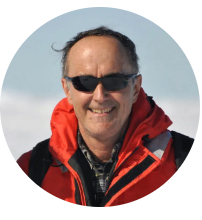Retreating sea ice is probably affecting your weather right now. The truth about sea ice from long-time Arctic expert Dr. Don Perovich. Which hemisphere is getting stormier and why? Professor Tiffany Shaw, leader of new science of storms explains. Plus global climate and energy tidbit news.
Listen to or download this Radio Ecoshock show in CD Quality (57 MB) or Lo-Fi (14 MB)
“The more clearly we can focus our attention on the wonders and realities of the universe about us, the less taste we shall have for destruction.”
– Rachel Carson
Can I bore you with news about a climate spinning out of our comfort zones? Can we pay attention to anything? It is so hard trying to protect the future when we have, right now: a triple pandemic, war splitting the world, worries about staying warm or fed, political turmoil and a lot of unhappy people. But if we want to survive, we have to carry all that AND change our lives dramatically to save a livable climate. Who knows if humanity can do it.
This program relays important new science about the way this planet works. We learn about critical sea ice from a long-time expert. Then you get a new look into why the world is becoming a more stormy place, and where. My hope: some of you will learn and pass it on. Nobody learned this key information in school, because we did not know it then. We need a thousand thousand ambassadors for climate reality. Don’t argue. Teach.
==========================================
Communicating science of the future is a lot of what Radio Ecoshock does. The awful truth goes out weekly to at least 106 radio stations every week, in four countries. The I post most of my research notes right here for you. With no advertising, there is no revenue stream beyond a few hardy donors who keep this show going. Your help would be appreciated! Please donate what you can here.
============================================
TRUTH ABOUT SEA ICE – DON PEROVICH
North America got early cold and snow this year. The UK and Europe too. Part of it is the Pacific Ocean system called La Nina. But there is something else, quite unexpected. Loss of Arctic sea ice may already influence weather further south. Maybe in good news, scientists also found a mechanism that may delay complete disappearance of Arctic sea ice. But we can’t get to how and why without understanding new science about ice, the ocean, and the atmosphere. A new paper shows us more.
The lead author is Long Lin from the Polar Research Institute of China. We reached his co-author, Dr. Donald Perovich. Don is a Professor of Engineering at Dartmouth in Hanover New Hampshire, USA. Don has chaired the Climate and Cryosphere Arctic Sea Ice Working Group. In addition to his own research and papers, he has co-edited peer-reviewed journals and has been funded by NASA.

We are talking about the new paper “Changes in the annual sea ice freeze–thaw cycle in the Arctic Ocean from 2001 to 2018”, in the European Geosciences Union journal The Cryosphere.
There are several breakthroughs in this new work. Dr. Perovich says the real leaders in this work are the Chinese scientists. China has invested heavily in climate research. There are large numbers of very bright young scientists coming up through universities there, like Ruibo Li, PhD student at the Nanyang Technological University, and the Lead Author Long Lin from the Polar Research Institute of China. Don agreed to help English language speakers understand the work.
A FROZEN OCEAN SURFACE
The sea ice is like a room divider between the ocean and the atmosphere. Both of those systems are turbulent, full of currents. This paper is fairly technical. The team of scientists, led by Long Lin, examined conditions not just at the top of the ice, which satellites see, but at the ice bottom, in contact with the ocean. It turns out that really matters.
For the purposes of measuring the amount of sunlight reflected back into space (albedo), the amount of surface sea ice is what counts. This varies, building to a peak in late March, and a low-point in September, following those 24 hour days of sunlight at the Pole. There are other factors, including ocean currents but especially winds and storms, which can break up sea ice and drive some of it out into the Atlantic or Pacific Ocean.
The decline of sea ice appears to come in steps, sometimes changing pretty suddenly. That possibility was predicted by a science paper published in 2006. That is “Future abrupt reductions in the summer Arctic sea ice” led by Marika M. Holland. The very next year it happened! Sea ice retreat in 2007 shocked scientists around the world as a huge signal of climate change, and a driver of even more heating. More of the dark ocean was exposed for longer periods, absorbing heat instead of reflecting it away. Earth experienced even lower sea ice for a new record in 2012. Former levels have never recovered.
The timing of sea ice formation is key to this game-changing energy event. If sea ice melts earlier, even by a few days, and then forms later, the amount of energy transfer is enormous, likely more than all the energy used by humans.
WHAT GOES ON BELOW
Now we learn that thaw and growth of sea ice is different at the bottom. Thaw below the surface may begin earlier and form later. This also has several impacts on the climate, and on living things around the Arctic. This team used a type of floating remote sensors, known as xxx. Our guest Don Perovich is a long-time expert in reading what these buoys tell us about sea ice.
According to their Press Release: “The researchers found that the overall average basal freeze onset of Arctic multiyear ice was almost 3 months later than the surface. According to Lin, although thinner ice generally experiences a longer freezing season, the total ice growth still cannot offset the sea ice loss in summer. ’From another point of view, the self-regulation of the Arctic sea ice-ocean system will delay the loss of Arctic sea ice.’“
It sounds like the timing of thaw at the bottom may affect the rate of sea ice loss and the balance of ice in the Arctic. You can read the paper or listen to this interview to find out more.
THE BRAKES ON SEA ICE DECLINE?
In the interview, our guest clearly explains a kind of braking system built into the process of sea ice thaw. The paper suggests that could delay a complete disappearance of sea ice in summer, or eventually, all year. Some scientists expect a “blue ocean event” (no sea ice except around a few Canadian Arctic islands) within the next few years. All the requirements for no ice are present, but some remains. This paper explains why.
SAM CARANA HAS SOME UP TO DATE SEA ICE DATA HERE
AND CHECK OUT THIS SUPER ARTICLE ON WHAT TO EXPECT THIS WINTER IN THE NORTHERN HEMISPHERE
From: SEVERE WEATHER EUROPE
“Sea Ice and Snow Extent in the Northern Hemisphere are now in Their Major Growth phase Representing key Elements in the Formation of the Chilly Winter Reservoir” By Renato R. Colucci, published 03/12/2022
“The Arctic sea ice extent is actually growing really fast in these weeks, as should be at this stage of the season. On December 1st, the Arctic sea ice extent was about 10.5 million square kilometers (3.77 million square miles), which is perfectly in agreement with the 2010s mean growing rate, according to the National Snow & Ice Data Center of Boulder, Colorado (US). … Moreover, the increase in atmospheric water vapor content in the Arctic region during late Fall and winter, driven locally by the reduction of sea ice provides enhanced moisture sources, supporting increased heavy snowfall in Europe during early winter and the northeastern and midwestern United States during winter. To sum up, the recent decline of Arctic sea ice has played a critical role in recent cold and snowy winters.”
Projecting longer-term weather by Siberian snow cover is a specialty developed by our guest Judah Cohen. Dr. Judah Cohen explains why waves of extreme cold and snow are more likely – BECAUSE the world is warming. Reduction of sea ice can lead to colder snowier winters in North America or Europe. That is counter-intuitive, but explained in the article above by Colucci. I check out Severe Weather Europe regularly. It is a good place to understand basic climate science – explained in terms of what we experience now.
GETTING HAMMERED WITH SNOW? SEE: “Regions of intensification of extreme snowfall under future warming” Open Access Published: 17 August 2021 Authors: Lennart Quante, Sven N. Willner, Robin Middelanis & Anders Levermann
SEE ALSO
“The Arctic Ocean and Mid-Latitude Connections: Is Loss of Arctic Sea Ice Making the Weather Worse?” recorded by
Paul Beckwith at COP27. The audio is poor but understandable, and the graphics are very informative. It is a presentation by Bimochan Niraula at the International Cryosphere Climate Initiative, COP27 Egypt.
==============================================
IS THE WORLD GETTING MORE STORMY? WHERE?
Early winter storms rock North America and Europe. Network news has become a weather-cast, reporting waves of extreme events. But is the world really becoming a stormier place?
Dr. Tiffany Shaw and her team investigated, just releasing their new paper in the Proceedings of the National Academy. At the University of Chicago, Tiffany is Professor in the Department of the Geophysical Sciences . She gained her Doctorate in Physics at the University of Toronto. Dr. Shaw has led or co-authored over 50 peer-reviewed papers, many of them examining Earth energy systems.
The paper is available free (open access). The title is: “Stormier Southern Hemisphere induced by topography and ocean circulation”.

We get answers to questions like: now that Earth is warming, is the Northern Hemisphere becoming more stormy? How could a decrease of sea ice or land snow affect storms in the Northern Hemisphere? How can you tell the Southern Hemisphere has become more stormy, and since when?
If the global south becomes even stormier, and if global warming is a driver, that could be a further case of the injustice of climate impacts. It may bear on the need for reparations from industrialized countries, as discussed at COP27.
In this new paper we find: “In the Northern Hemisphere, storminess has not changed significantly consistent with oceanic and radiative (increased absorption of sunlight due to the loss of sea ice and snow) changes opposing one another.” Does that mean less ice and snow in the Arctic has calmed storms further south, actually stalled off an impact of climate warming for industrialized countries in the North?
Two Chinese scientists just published a study finding even weak tropical cyclones have grown more intense. That caught my eye after seeing a relatively weak Cat 1 Hurricane Nicole, barely above a tropical cyclone – and yet did so much damage to Florida and up the East Coast.
In the interview, Tiffany Shaw mentions Syukuro Manabe, who shared the 2021 Nobel Prize in Physics “for the physical modelling of Earth’s climate, quantifying variability and reliably predicting global warming”. As the Nobel citation says:

“Syukuro Manabe demonstrated how increased levels of carbon dioxide in the atmosphere lead to increased temperatures at the surface of the Earth. In the 1960s, he led the development of physical models of the Earth’s climate and was the first person to explore the interaction between radiation balance and the vertical transport of air masses. His work laid the foundation for the development of current climate models.”
=========================================
CLIMATE AND ENERGY TIDBITS
Strange weather continues in many parts of the world. China, which stayed hot for months, recently dropped 16 degrees C. into bitter cold. According to Jim Yang: “It was the strongest cold wave in November since 1987, and its comprehensive intensity ranked the fourth since 1961”. All the coal burners in China are cranking up, creating dangerous pollution.
That is happening in Europe too this winter due to the cutoff of Russian gas. There is a thick smoke of Poland, with some people reported digging for coal in their backyards to keep warm this winter. One expert predicted an extra 1500 premature deaths in Poland just because of coal smoke this winter. Germany bought more coal from South Africa. The UK just approved the first new coal mine in 30 years! The war has led to a great leap backward in dirty fossil fuels. We will all pay for that.
UK coal mine approval sparks global fury and hypocrisy claims
Strong winter storms sweep over North America, like a procession. Then there’s Utqiagvik, formerly known as Barrow, on the northern point of Alaska. They just got their hottest day ever recorded for the winter, November through March, ever recorded. It was 40 degrees C. or 4.4 C. It is another winter heat record with hotter years to come.
But it was roasting in the U.S. south early this December! Dozens of high temperature records for the day were broken, going over 80 degrees F., and many more all-time records for night-time highs were broken.
THE DOUBLING HAS COME
Australia is sizzling, hitting 46 degrees C in the Northwest. The Australian Bureau of Meteorology and CSIRO just released their 2022 State of the Climate Report. They calculate CO2 Equivalent is now 516 ppm – almost double pre-industrial levels of 278-280. That is how high the global warming gases really are, when we include methane, nitrous oxide, and a whole slew of highly potent chlorinated chemicals up there. The Doubling – here we are. I will have more on that in the New Year.
Reports to the Intergovernmental Panel include a number of different pathways, from an unreal 1.5 degrees warming up to a mistakenly low 3 degrees C. Reading the Australian report, Canada’s Dr. Peter Carter says we are enacting the “insane suicide scenario”.
BRINGING BACK ANCIENT LIFE
According to New Scientist: “A 48,500-year-old virus has been revived from Siberian permafrost. Seven viruses from the Siberian permafrost have been revived and replicated themselves in the lab – including the oldest revived so far. Permafrost is thawing across Russia, Canada, and Alaska. It is stuffed with organic life forms, some of which can survive very long times. A number of scientists have called for closer monitoring, before a surprise virus or bacteria joins the modern age for the first time.”
WHAT TO DO?
What are we supposed to do with all this worrying information? Aside from obvious retreat from fossil power and destruction of nature generally, we can change minds. I know many don’t want to hear bad news from the climate front. They also don’t want a heat wave lasting months, coasts washed away, and wildfires roaring down the hills. I forgot the flash flooding rain, years-long droughts for others, and a thousand other losses, from insects to beasts that we love. Don’t argue. Teach. Share the joy of discovering how this planet and our universe actually work!
“The more clearly we can focus our attention on the wonders and realities of the universe about us, the less taste we shall have for destruction.”
– Rachel Carson
Hi Alex, have been missing the shows, time to get back at it. I see good titles since the summer.
Is this a typo somehow They calculate CO2 Equivalent is now 516 ppm – almost double pre-industrial levels of 178-180. double 180 is only 360?
Hello Ian
Yes, that was a typo. The preindustrial greenhouse gas levels should be 278 to 280 ppm. Thanks for your eagle eye.